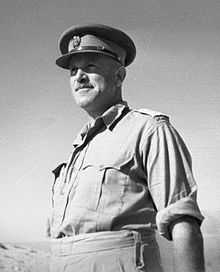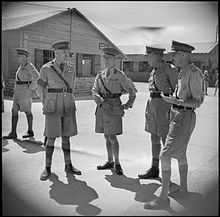Reginald Miles
| Reginald Miles | |
|---|---|
 Brigadier Miles, 1940-1941 | |
| Born |
10 December 1892 Springston, New Zealand |
| Died |
20 October 1943 (aged 50) Figueras, Spain |
| Buried at | Figueras Municipal Cemetery, Figueras |
| Allegiance |
|
| Service/branch |
|
| Rank | Brigadier |
| Battles/wars |
First World War
Second World War |
| Awards |
Commander of the Order of the British Empire Distinguished Service Order Military Cross Cross of Valour (Greece) |
Brigadier Reginald Miles, CBE, DSO & Bar, MC (10 December 1892 – 20 October 1943) was a professional soldier in the New Zealand Military Forces who served during the First and Second World Wars.
Born in 1892, he was a New Zealand entrant into the Australian Royal Military College, from which he graduated in 1914. He served as an artillery officer in the First World War and was awarded the Distinguished Service Order for his actions during the Spring Offensive. He remained in the military after the war, holding various artillery commands for the next several years. When the Second World War broke out, he was the Quartermaster General of the New Zealand Military Forces. In 1940, he was seconded to the 2nd New Zealand Division as its commander of artillery. He served during the Battle of Greece and later during Operation Crusader in North Africa. He was captured during fighting near Tobruk in late 1941. He was held in a prisoner of war camp in Italy but, with five other officers including fellow New Zealander James Hargest, escaped in April 1943. He had made his way to Spain when, overcome with depression, he committed suicide in October 1943.
Early life
Reginald Miles was born in Springston, near Christchurch on 10 December 1892 into a New Zealand farming family. Educated at Rangiora High School, he was commissioned in the school cadets in 1910. He was one of the limited number of officer cadets from New Zealand who, in 1911, enrolled in the Royal Military College in Duntroon, Australia.[1]
First World War
Miles was in the final year of his cadetship at Duntroon when the First World War broke out. He graduated in November 1914 as the top cadet from New Zealand. He volunteered for the New Zealand Expeditionary Force and embarked for Egypt in December 1914.[1] He served as a captain in the New Zealand Field Artillery during the Gallipoli Campaign and was badly wounded in July 1915. After recovering from his wounds, he served on the Western Front. He participated in the Battle of the Somme and as a result of his gallantry was awarded the Military Cross in December 1916. In May 1917 he was promoted to major and appointed commander of a howitzer battery.[2]
The following year Miles was made a Companion of the Distinguished Service Order (DSO), having originally been recommended for the Victoria Cross, for his actions during the German Spring Offensive. His battery had come under threat from an advance by the enemy. He rounded up nearby infantry to reinforce his positions, which had nearly exhausted its ammunition, and manned a fire trench. He then undertook a reconnaissance ahead of his position but was wounded by sniper fire. After recuperating, he returned to active service in July as brigade major of the Field Artillery of the New Zealand Division. He was mentioned in dispatches in November 1918.[1]
Interwar period
After his return to New Zealand, Miles served as commander of Wellington harbour's defences. In 1924 He went to England to attend the Staff College at Camberley, after which he undertook a number of specialist artillery courses. He returned to New Zealand in 1926 and, after a period at Army Headquarters in Wellington, he was posted to Auckland to command artillery there. In 1937, he was promoted to colonel and appointed commander of the Northern Military District. The following year he was sent to England to attend the Imperial Defence College. He was then attached to the War Office for three months before returning to New Zealand in 1939. In September 1939, he was appointed Quartermaster General of the New Zealand Military Forces.[1]
Second World War

In 1940, Miles was promoted to brigadier and seconded to the newly raised 2nd New Zealand Division as the commander of its artillery.[2] He spent the early part of the war in England, commanding the 2nd Echelon of the division which had been diverted there while in transit. An initial attempt to join the main part of the division in the Middle East in October 1940 was foiled when the ship he was travelling on was bombed and forced to return to England.[3] He served in the Greece campaign and played a key role in the organisation of the withdrawal of the division as it retreated ahead of the advancing Germans, and was mentioned in dispatches for his work during this period.[1] He was also awarded the Greek Cross of Valour.[4] He was evacuated ill back to Egypt and missed the Battle of Crete, which involved most of the division.[1]
After convalescing, Miles re-joined the division in North Africa, where it was reforming after the losses incurred in Greece and on Crete. He then participated in Operation Crusader.[2] On 1 December 1941, in fighting near Tobruk, his 6th Field Regiment was overrun by German forces near Belhamed. Miles, on an inspection of the battle zone and trying to encourage his men, was wounded and taken prisoner.[1]
Together with Brigadier James Hargest, the commander of the New Zealand 5th Infantry Brigade and who was also captured around the same time,[2] Miles arrived in the Italian prisoner of war camp Vincigliata PG 12 in 1942. The camp was a medieval castle near Florence where he found himself amongst illustrious company such as Lieutenant General Sir Philip Neame VC, General Sir Richard O'Connor and Air Marshal Owen Tudor Boyd. Miles settled into camp routine and became a gardener,[5] and was actively involved in escape attempts. He, together with Hargest, escaped[6] to Switzerland through a tunnel which he helped to build, in April 1943.[2] Neame received a coded letter announcing their success a fortnight later.[7]
Miles received a bar to his DSO for his efforts in escaping from Italy.[2] In Switzerland, Miles and Hargest split up and both traveled independently. As Hargest wrote in his book Farewell Campo 12, "I was over in Lucerne when Miles rang up to say he was off, and to suggest I should follow him later".[8] However, having travelled as far as the Spanish frontier on 20 October 1943, and in a state of depression and exhaustion, he shot himself. He was buried with military honours, and escorted to his final resting place in the Figueras Municipal Cemetery by members of the British Consulate and a party of Spanish officers.[9]
Miles was posthumously appointed a Commander of the Order of the British Empire in 1944. He was survived by his four daughters from his marriage to Aimée Zita Donnelly, who he had married in Egypt in 1916, and his second wife, Rosalind Georgette Bisset-Smith who he had married in 1940 following the death of his first wife a few years previously. His second marriage did not result in any children. His only son was a lieutenant in the Fleet Air Arm and also served in the Second World War. He was killed travelling on board HMS Glorious when the ship was attacked and sunk by the German battleships Scharnhorst and Gneisenau off Norway on 8 June 1940.[1]
Notes
- ↑ 1.0 1.1 1.2 1.3 1.4 1.5 1.6 1.7 Clayton, Garry James. "Miles, Reginald". Dictionary of New Zealand Biography. Ministry for Culture and Heritage. Retrieved June 2013.
- ↑ 2.0 2.1 2.2 2.3 2.4 2.5 McGibbon, 2000, p. 319
- ↑ McClymont,1959, pp.38–40
- ↑ Haigh & Polaschek, 1993, pp. 173–174
- ↑ de Wiart, 2007, p. 194
- ↑ Neame, 1947, p. 303
- ↑ Neame, 1947, p. 308
- ↑ Hargest, 1945, p. 145
- ↑ Hargest, 1945, p. 179
References
| Wikimedia Commons has media related to Reginald Miles. |
- Haigh, J. Bryant; Polaschek, A. J. (1993). New Zealand and The Distinguished Service Order. Christchurch, New Zealand: Privately published. ISBN 0-473-02406-3.
- Hargest, James (1945). Farewell Campo 12. London: Michael Joseph. OCLC 480503441.
- McClymont, W. G. (1959). To Greece. Official History of New Zealand in the Second World War 1939–45. Wellington, New Zealand: War History Branch. OCLC 4373298.
- McGibbon, Ian, ed. (2000). The Oxford Companion to New Zealand Military History. Auckland, New Zealand: Oxford University Press. ISBN 0-19-558376-0.
- Neame, Sir Philip (1947). "Playing with Strife", The Autobiography of a Soldier. London: George G. Harrap & Co. OCLC 1541023.
- De Wiart, Adrian Carton (2007). Happy Odyssey. London: Pen & Sword. ISBN 978-1-84415-539-2.